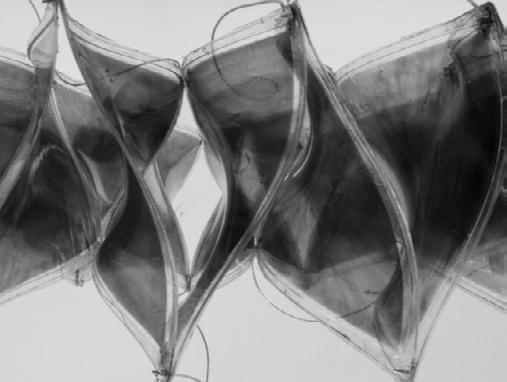
3 minute read
1.2_MATERIALLY DRIVEN RESPONSIVE ARCHITECTURE
from Towards a Lively Architecture - Exploring Response in Bent Wood Assemblies | Thesis by David Heaton
by David Heaton
fig. 03 - Bloom (Doris Sung, 2011)

Advertisement
PERFORMATIVE ACTOR:
Recent developments of “performative” materials offer an opportunity to design material behaviors as opposed to choosing materials based on their static properties. These performative materials behave in response to the active energy fields existing within and around the “systems” we program. However, the introduction of these materials calls for careful consideration of all of the building elements we use. The behaviors exhibited within “smart” materials can be physically programmed or even naturally found in materials such as wood. These materials exist in a variable environment and therefore we should explore the embodied potential each of these materials has to respond to its environment if we are to design with material behaviors in mind. This idea of performative materials changes our notion of materials as a static element to one in which the material acts as a mediator. (Rashida, Patel 2013) This allows us to view the interface between materials, people, and their environment all as actors within a system. Material information should become a generative driver rather than an afterthought in design computation. (A. Menges, 2012)
If we begin to understand the way materials naturally react, design can enhance these natural responses and reactions. This can be done through the development of new tectonic types designed for material behavior. This would mean a shift from the current typologies of frames designed specifically for a material’s static properties to new forms that welcome their dynamic properties.
Synthetic Material Response:
The following section contains examples of materially driven responsive projects using synthetic man made materials as passive or active actuators in a system.
Bloom (Doris Sung, 2011) is a structure designed for shading and ventilation. This project incorporated bimetallic strips as its actuator. This is a process by which two different types of metal with different expansion coefficients are attached. As heat is applied, the metal expands at different rates, causing deformation. Bloom consists of a large surface array of bimetallic panels that when heated by the sun, curl to allow heat to escape the space and as they cool, close again.
Smart Screen III (Decker Yeadon, New York, 2010) uses shapememory alloy (SMA) wire to replace the mechanism inside of window blind units in a building. SMA is a material that “remembers” its original shape returns to it when heated. Instead of having a mechanical solution to raise and lower blinds, the SMA wire replaces that assembly. As the sun heats the facade the wire slowly retracts raising and lowering the blinds.
Living Glass (David Benjamin and Soo-in Young 2004-2005) is a project that incorporates shape memory alloys. These allows have the ability to recall their original shape when heated. This process can happen repeatedly giving the materials a ‘memory’. Living Glass uses a lightweight silicon skin with gill like slits in it as a building ventilation system. The dynalloy flexinol wires are electrically heated to cause the slits to open, ventilating the space. The opening and closing of the system is regulated through sensors that measure the space’s carbon dioxide levels.
Shape Shift (ETH Zurich, 2010) is a project exploring the use of electroactive polymer (EAP) as a building shading and ventilation system. EAPs are a type of polymer that can alter its shape based off of an electrical charge. This system consists of an array of biologically inspired panels. Each panel is framed in acrylic with the center being layered EAP. When a charge is placed, the system can morph its shape.
fig. 05 - Living Glass (David Benjamin and Soo-in Young 2004-2005)












